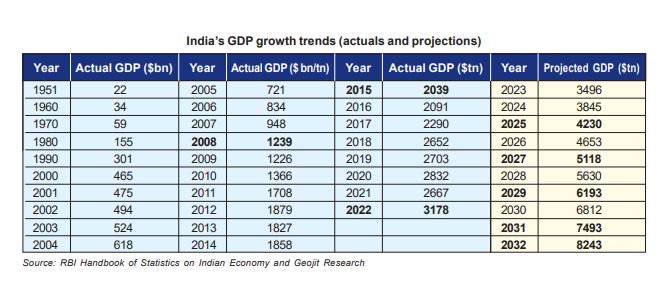India is the most expensive stock market in the world now. High valuations reflect high expectations. Investors – both domestic and foreign – are investing based on the India Growth Story.
Why are investors so bullish on India?
How bright are India’s growth prospects?
What should be the investment strategy?
India Growth Story has never been so good
It is well known that “in the long run the market is a slave of earnings.” Earnings growth and GDP growth are correlated. Since initiation of liberalization in 1991, India has been the second fastest-growing large economy in the world, second only to China, and now with China’s growth fading, India is the fastest-growing large economy. The three Ds -demographics, digitization, domestic consumption, and democracy- are powering India’s growth. Pro-business economic policy is helping India’s entrepreneurs to grow and prosper.
India’s $3.7 trillion dollar economy is now the fifth largest economy in the world and is projected to be the third largest by 2027-28. There is a near consensus among think tanks that India will become an $8 trillion economy by 2032. India’s growth has been steady and impressive and, therefore, the projections are achievable. See the table.
As the economy grows, the number of years taken to add an additional $1 trillion to the GDP declines. As the table indicates:

India took 60 years to become a $1 trillion economy
7 years to become a $2trillion economy
7 years to become a $3trillion economy
4th trillion will happen in 3 years
5th trillion in 2 years
6th trillion in 2 years
7th trillion in 2 years
8th trillion in 1 year
Barring unforeseen events this is inevitable.
GDP growth will bring impressive growth in earnings
It is important to understand that as the GDP grows corporate earnings will grow disproportionately. Of the three sectors of the economy – agriculture, industry, and services – agriculture can at best grow at around 4 percent. Industry and services can grow much faster. So, when India grows at, say, 7 percent, bulk of the contribution will come from industry and services which can grow at more than 8 percent in real terms. The stock market is largely composed of companies from industry and services. This is the reason why corporate earnings grow faster than GDP growth: the stock market reflects this. In 1990-91 India’s GDP was around $310 billion and the Sensex was at 1,000. Now, the GDP is $3.7 trillion, and the Sensex is around 66,000. It is important to note that post liberalization, while GDP multiplied around 10 times the Sensex multiplied 66 times. The long-term growth in Sensex tracks earnings growth.
Investors should be focused on the long-term growth story of India. India is on course to become an $8 trillion economy by 2032 with a market cap of around $10 trillion. The next decade is going to witness unprecedented wealth creation through the stock market. Investors have a golden opportunity to participate in this historic wealth creation. To profit from this potential wealth creation, investors need to follow a simple investment strategy. One, refrain from reckless speculation and trading in the market. Two, invest systematically ignoring the short-term fluctuations. Three, remain invested without trying to time the market. This simple investment strategy will fetch handsome rewards in the years to come.







